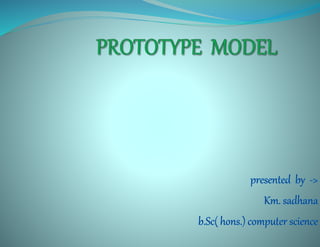
Prototype model
- 2. Overviews:- What is prototype model? Need / importance of the prototype model Advantage and disadvantage of the prototype model Reference
- 3. Sdlc models SDLC(Software development life cycle) is a framework that describes the activities performed at each step of a software development project. SDLC models are following types:- Waterfall model Iterative model Prototype model Spiral model
- 4. SDLC MODEL
- 5. Prototype model A prototyping model suggest that before carrying out the development of the actual software, a working prototype of the system should be built. A prototype is a toy implementation of the system. Prototype is a working model of software with some limited functionality. Prototyping is used to allow the users evaluate the developer proposals and try them out before implementation.
- 6. How does the prototype model look? aa Requirement analysis quick design Build prototype Customer evaluation of prototype Refine requirements according to the customer suggestion Design Implement Test Maintain
- 7. Steps of the prototype model Requirements gathering and Analysis: A prototype model begins with requirements analysis, and the requirements of the system are define in detail. The user is interviewed in order to know the requirements of the system. Quick design: When requirements are known, a quick design for the system is created. It is not a detailed design , it includes the important aspects of the system, which gives an idea of the system to the user.
- 8. Build prototype: Information gathering from quick design is modified to form a prototype .It represents a ‘rough’ design of the required system. Customer evaluation of prototype: The build prototype is presented to the customer for his/her evaluation. Prototype refinement: Once the user evaluate the prototype, it is refined according to the requirements . When the user is satisfied to the developed prototype , a final system is developed based on the final prototype , which is developed by the iterative method means we design the system according to the final prototype , after that implement , test the product to find the error and at last we maintain the system.
- 9. Need of the prototype model:- Prototype provides a method to examine design problems and evaluating solutions. “…Prototypes are not self explanatory….Clarifying what aspects of a prototype correspond to the eventual artifact─ and what don’t─ is a key part of successful prototyping.” The development of the prototype model is expensive but is a good model because it satisfy all the requirements of the customers.
- 10. Advantages of the prototype model:- It provides a working model to the user early in the process , enabling early assessment and increasing the user confidence. The developer gains the experience and insight by developing a prototype , thereby resulting I better implementation of the requirements. It helps in reducing the risk associated to the project. The prototyping model serves to clarify requirements , which are not clear, hence ambiguity and improving communication between developer and user.
- 11. There is a great involvement of the users in software development. Hence the requirements of the users are met to the greatest extent.
- 12. Disadvantages of the prototype model If the user is not satisfied with developed prototype, then a new prototype is developed . This process goes on until a perfect prototype evolves. Thus this model is time consuming and expensive. The developer loses focus of the real purpose of the prototype and compromises on the quality of the product. For example:- he/she may apply some of the inefficient algorithms or inappropriate programming languages used in developing the prototype.
- 13. Prototype model can lead to the false expectations. It often creates a situation where the user believes that the development of the system is finished when it is not. The primary goal of the prototype model is rapid development. Thus, the design of the system may suffer as it built in a series of layers without considering integration of all the other components.
- 15. thank you